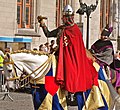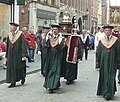Procession of the Holy Blood: Difference between revisions
m Dating maintenance tags: {{Merge to}} |
Manannan67 (talk | contribs) added ref |
||
| Line 5: | Line 5: | ||
[[File:SANGUIS BRUGENSIS14 44.JPG|thumb|Procession of the Holy Blood, 2014]] |
[[File:SANGUIS BRUGENSIS14 44.JPG|thumb|Procession of the Holy Blood, 2014]] |
||
[[Image:Procession of the Precious Blood of Jesus Christ-Bruges; het conopeum.JPG|thumb|The conopeum]] |
[[Image:Procession of the Precious Blood of Jesus Christ-Bruges; het conopeum.JPG|thumb|The conopeum]] |
||
The '''Procession of the Holy Blood''' ({{lang-nl|Heilig Bloedprocessie}}) is a large religious Catholic [[procession]], dating back to the [[Middle Ages]], which takes place each [[Ascension Day]] in [[Bruges]], [[Belgium]]. |
The '''Procession of the Holy Blood''' ({{lang-nl|Heilig Bloedprocessie}}) is a large religious Catholic [[procession]], dating back to the [[Middle Ages]], which takes place each [[Ascension Day]] in [[Bruges]], [[Belgium]]. In 2009, it was included in the [[UNESCO]] [[Representative List of the Intangible Cultural Heritage of Humanity]]. |
||
== History == |
== History == |
||
| Line 15: | Line 15: | ||
More than 3,000 people of Bruges participate in the spectacle, which is also called "''Brugges Schoonste Dag''" ([[Dutch language|Dutch]] for "The Most Beautiful Day in Bruges"). People of Bruges used to decorate their facades with flags in the colours of the City and country. |
More than 3,000 people of Bruges participate in the spectacle, which is also called "''Brugges Schoonste Dag''" ([[Dutch language|Dutch]] for "The Most Beautiful Day in Bruges"). People of Bruges used to decorate their facades with flags in the colours of the City and country. |
||
The event retains its formal spiritual aspect. Every year, the bishop and governor invite high diplomatic guests. Among the most famous guests were the archbishop of Krakow, Cardinal [[Karol Wojtyła|Wojtyła]], in 1973 and [[Cardinal Wiseman]] in 1849. |
The event retains its formal spiritual aspect. Every year, the bishop and governor invite high diplomatic guests. Among the most famous guests were the archbishop of Krakow, Cardinal [[Karol Wojtyła|Wojtyła]], in 1973 and [[Cardinal Wiseman]] in 1849. |
||
Many bishops, priests and nuns from all over the world come to celebrate this famous procession. In the morning, a pontifical Mass is celebrated in the cathedral, and, in the afternoon, the procession takes place. Clergy carry the relic on their shoulders, guarded by the brotherhood. When the relic of the Holy Blood passes by, the crowd becomes still and silent in reverence. |
Many bishops, priests and nuns from all over the world come to celebrate this famous procession. In the morning, a pontifical Mass is celebrated in the cathedral, and, in the afternoon, the procession takes place. Clergy carry the relic on their shoulders, guarded by the brotherhood. When the relic of the Holy Blood passes by, the crowd becomes still and silent in reverence. In 2009, the event was inscribed in the [[UNESCO]] [[Representative List of the Intangible Cultural Heritage of Humanity]].<ref>[https://ich.unesco.org/en/RL/procession-of-the-holy-blood-in-bruges-00263 "Procession of the Holy Blood in Bruges", UNESCO, Intangible Cultural Heritage]</ref> |
||
==Gallery== |
==Gallery== |
||
Revision as of 04:35, 22 December 2019
It has been suggested that this article be merged into Feast of the Most Precious Blood. (Discuss) Proposed since December 2019. |


The Procession of the Holy Blood (Template:Lang-nl) is a large religious Catholic procession, dating back to the Middle Ages, which takes place each Ascension Day in Bruges, Belgium. In 2009, it was included in the UNESCO Representative List of the Intangible Cultural Heritage of Humanity.
History
The centerpiece is the Relic with the Precious Blood of Jesus, a cloth supposedly with blood of Jesus Christ, brought to the city by Thierry, Count of Flanders after the 12th century Second Crusade. The Procession of the Holy Blood seems to have emerged as a civic ceremony by the late thirteenth century.[1] Instituted in 1303, the ceremonial procession commemorates the deliverance of the city, by the national heroes Jan Breydel and Pieter de Coninck, from French tyranny in May of the previous year and which takes place on Ascension Day, as one of the great religious celebrations in Belgium. Residents of the area perform an historical reenactment of the phial's arrival together with similar dramatizations of Biblical events. The passion play, the Jeu du Saint Sang takes place every five years.[2] Sixty to one hundred thousand spectators watch the procession, a parade of historical scenes and biblical stories. Choirs, dance groups (e.g. dance theatre Aglaja), animals (ranging from geese to camels), horse-drawn floats and small plays with many actors pass by within a couple of hours.
In 2015 the procession was cancelled, a few hours before it was scheduled to start, due to bad weather.[3]
Pilgrimage
More than 3,000 people of Bruges participate in the spectacle, which is also called "Brugges Schoonste Dag" (Dutch for "The Most Beautiful Day in Bruges"). People of Bruges used to decorate their facades with flags in the colours of the City and country. The event retains its formal spiritual aspect. Every year, the bishop and governor invite high diplomatic guests. Among the most famous guests were the archbishop of Krakow, Cardinal Wojtyła, in 1973 and Cardinal Wiseman in 1849. Many bishops, priests and nuns from all over the world come to celebrate this famous procession. In the morning, a pontifical Mass is celebrated in the cathedral, and, in the afternoon, the procession takes place. Clergy carry the relic on their shoulders, guarded by the brotherhood. When the relic of the Holy Blood passes by, the crowd becomes still and silent in reverence. In 2009, the event was inscribed in the UNESCO Representative List of the Intangible Cultural Heritage of Humanity.[4]
Gallery
-
Virgin Mary, May 2010
-
The history of the relic is performed for thousands.
-
Laurent Monsengwo Pasinya on the official viewing stand
-
Mgr De Kesel receives his high guests.
-
Other relics are carried in the procession.
-
Saint Donatus of Reims, patron of the diocese
References
- ^ Leeuwen, Jacoba (2006). Symbolic Communication in Late Medieval Towns. Leuven: Leuven University Press. p. 14. ISBN 978-90-5867-522-4.
- ^ Pan American Airways, ed. (1967). Complete reference guide to the Low Countries. Simon and Schuster. p. 9. Retrieved 17 July 2011.
- ^ Colin Clapson (2015-05-14). "Holy Blood Procession abandoned". flandersnews.be. Retrieved 2015-05-16.
- ^ "Procession of the Holy Blood in Bruges", UNESCO, Intangible Cultural Heritage
External links
- Heilig Bloedprocessie at the official website of the city of Bruges








